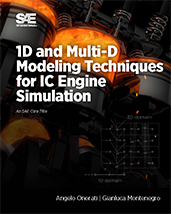Journal Article
1D Numerical and Experimental Investigations of an Ultralean Pre-Chamber Engine
2019-11-19
Abstract In recent years, lean-burn gasoline Spark-Ignition (SI) engines have been a major subject of investigations. With this solution, in fact, it is possible to simultaneously reduce NOx raw emissions and fuel consumption due to decreased heat losses, higher thermodynamic efficiency, and enhanced knock resistance. However, the real applicability of this technique is strongly limited by the increase in cyclic variation and the occurrence of misfire, which are typical for the combustion of homogeneous lean air/fuel mixtures. The employment of a Pre-Chamber (PC), in which the combustion begins before proceeding in the main combustion chamber, has already shown the capability of significantly extending the lean-burn limit. In this work, the potential of an ultralean PC SI engine for a decisive improvement of the thermal efficiency is presented by means of numerical and experimental analyses.


